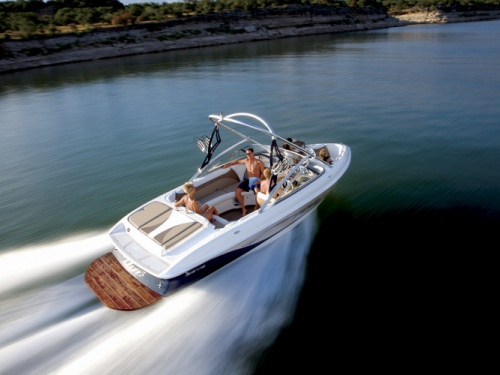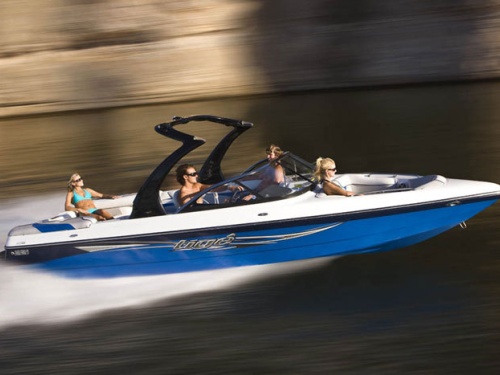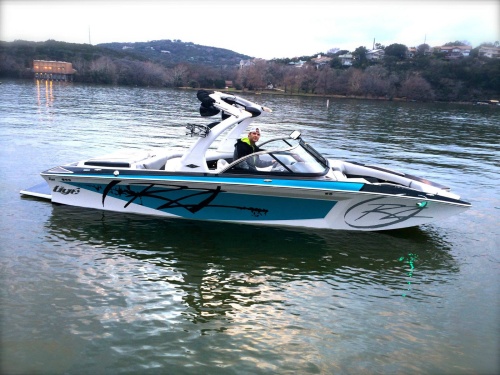Access More Boat Tests
Already have an account? Login
Tigé R20 (2011-2013)
1 x 303-hp PCM ProSport 5.0L MPI
Brief Summary
In case you haven't noticed, Tigé has been expanding its range of premium wakeboats lately. But builder has not forgotten the entry level price-point, and that is pretty much the mission of the R20. The price is lower, but the build quality is not. So how did Tigé keep the price down? And did they leave out too much? It was our mission to investigate those questions when we recently tested the new Tigé R20 model.
Key Features
- Oversized bow
- Low profile, max visibility dash
- Snap-in carpet
- Massive storage components
- PCM engines
- Walk over transom
- Transom activity center
Test Results
| RPM | MPH | Knots | GPH | MPG | NMPG | STAT. MILE | NM | dBa |
|---|---|---|---|---|---|---|---|---|
| 650 | 3.2 | 2.7 | 0.8 | 4.2 | 3.65 | 144 | 125 | 68 |
| 1000 | 5 | 4.3 | 1.1 | 4.55 | 3.95 | 155 | 135 | 71 |
| 1500 | 6.7 | 5.8 | 1.8 | 3.83 | 3.33 | 131 | 114 | 74 |
| 2000 | 8.6 | 7.4 | 3.1 | 2.76 | 2.4 | 94 | 82 | 81 |
| 2500 | 13 | 11.3 | 5 | 2.62 | 2.27 | 89 | 78 | 82 |
| 3000 | 23 | 20 | 6.6 | 3.51 | 3.05 | 120 | 104 | 83 |
| 3500 | 27.8 | 24.1 | 7.7 | 3.63 | 3.15 | 124 | 108 | 88 |
| 4000 | 32.3 | 28.1 | 9.7 | 3.35 | 2.91 | 114 | 100 | 89 |
| 4500 | 36.1 | 31.4 | 12.9 | 2.8 | 2.43 | 96 | 83 | 90 |
| 5000 | 39.8 | 34.6 | 16.6 | 2.4 | 2.09 | 82 | 71 | 90 |
| 5300 | 40.8 | 35.4 | 19.8 | 2.06 | 1.79 | 70 | 61 | 91 |
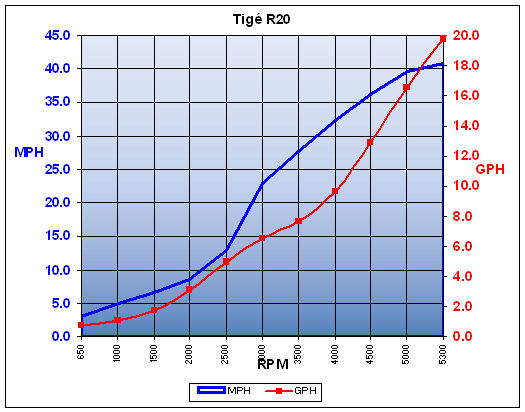
Specifications
| Length Overall | 20' 0'' / 6.1 m |
|---|---|
| Beam |
94'' 2.39 m |
| Dry Weight |
3,489 lbs. 1,582 kg |
| Draft | N/A |
| Deadrise/Transom | N/A |
| Max Headroom | open |
| Bridge Clearance | N/A |
| Fuel Capacity |
38 gal. 143.8 L |
| Water Capacity | none |
Acceleration Times & Conditions
| Time to Plane | 2.4 sec. |
|---|---|
| 0 to 30 | 5.3 sec. |
| Ratio | 1.46 : 1 |
| Props | 13.5 x 16 x 4 |
| Load | 2 persons, full fuel, no water, minimal gear |
| Climate | 60 deg.; 52% humidity; wind: 10-15 mph; seas; light chop |
Engine Options
| Tested Engine |
1 x 303-hp PCM ProSport 5.0L MPI |
|---|---|
| Std. Power |
1 x 303-hp PCM ProSport 5.0L MPI |
| Opt. Power |
1 x 343-hp PCM EX343 |
Captain's Report
Captain's Report by Capt. Steve--
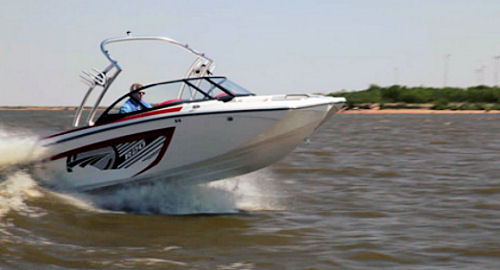
Mission Statement
The Tigé R20 was designed to provide an entry level wakeboat that still maintains the company’s demand for performance and construction quality. The price is kept down by eliminating most of the upgrades and options found on the more expensive boats in the lineup. By using the same hull at the more pricey boats, the ride quality is not sacrificed.

Differentiating Features
•
Inboard Engine.
True wakeboats are able to get a better wake, with a better table between the wakes, with inboard propulsion. Tigé will not compromise on this so the R20 makes a good transitional boat to inboard power.
•
Engine in stern.
Other wakeboats mount the engine in the middle of the boat, creating a huge engine box right in the center of the cockpit. It’s in the way, it’s ugly, it’s not necessary. With a V-drive transmission, Tigé is able to move the engine to the stern, where it belongs.
•
Choice of panels.
This year Tigé gives you a choice of the standard helm panel or a classier upgraded version. It's one more on a long list of optional features that this boat offers.
•
Pickle-fork bow.
This allows Tigé to carry most of the R20 beam fully forward providing much more room in the bow.
•
Poseidon mat.
Rather than put regular snap-in carpet in the R20, Tigé what with the Poseidon mat which is made from a synthetic material the drains water better and promotes faster evaporation. This is an important feature when dealing with a boat made specifically for watersports. At one point or another nearly all of the occupants will be coming back on board wet.
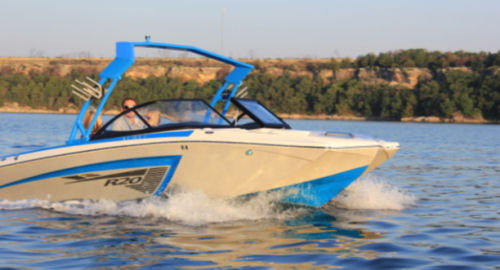
Build Quality
Usually when I see a builder making an entry level boat, all my mental alarms start going off. Now it's time to see cheap seats, plastic everywhere, cheap metal instead of 316 stainless steel… the usual suspects.
Not so with Tigé. Apparently they decided to take a different tack, and use the same build quality, same Convex V hull, and same performance ride, but in a less costly boat. So if the build is the same, then it must be the components, the accessories and amenities, right?
As it turns out, yes. But not like you'd think. They're still using stainless steel hardware etc… but not much of what I'd call the "fluff" components. All options are left where they belong, on the options list, and therein lies the secret of keeping the price down. Of course you can still opt up to your heart's content, but if that's the case, you'll end up driving up the price, and out of the mission of this boat.
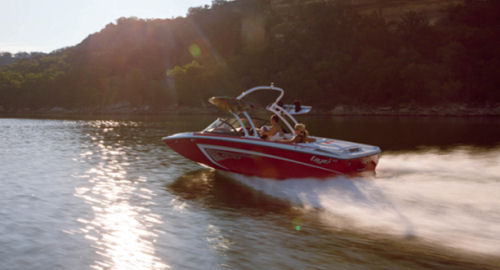
Out With the Fluff
Case in point is the tower. Where the other boats in the lineup are using the classy Alpha Z tower, this one is utilizing the more basic, and therefore less costly, aluminum pipe frame tower. It's still collapsible, with fixed racks, but that's about it. Now again, remember you can opt up if you really want to.
Options for the tower include, Wet Sounds speakers, swivel board racks, powder coating to color match the boat, and a Bimini top forward. And all that drives the price up, so do you really need it? Well in my case, at least the Bimini! (Boating is less fun when my fair skin bursts into flame from sunburn.)

Helm
The helm panel wasn't spared in the cost savings department. You still get the Speedset to maintain, and make incremental corrections to, your speed. But gone is the coveted Tigé Touch touch-screen. Tigé Touch is great to have, but it is costly and after all it doesn't actually make the wake, so do you really need it? How about the premium stereo? Won't the basic tunes work just as well?
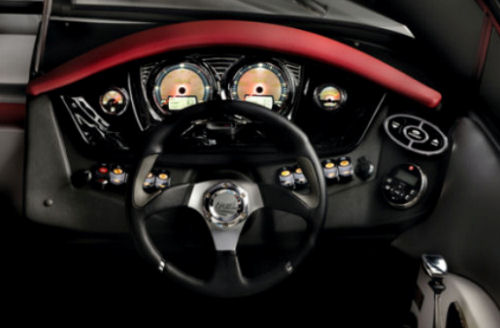
This year, Tigé is also offering another option for the helm beyond Tigé Touch. Like an entirely new and upgraded helm. It’s a gorgeous panel that has the look and feel of a high-end sports car.

Little Things Add Up
Even some small items are cut out in order to keep the price down. At the transom, for example, there's no grab handle to hoist yourself onto the swim platform with. Because the platform is so low for most boarders it won't even be missed. How about the helm seat? It's not the mesh seat and back of the higher-end boats, but it's still well padded, and includes a flip-up bolster.
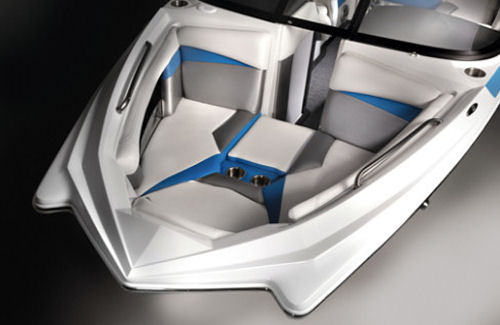
Keeping the Fat
But first and foremost, Tigé's mission in life is to produce premium wake not matter what the cost of their boats. It is here that I think Tigé' excels, although their boats are also equally as good for skiing and, in the case of the R20, a good all-around sport boat for the family. In order to remain competitive, and make no mistake, these boats are competitive, Tigé has come up with a triple whammy for creating the wake the kids and the young-at-heart long for.
First -- The Hull Shape:
Tigé has reconfigured the traditional skiboat hull (where you want a flat wake) into one designed to help create wake. The hull design is called Convex V. Where other wakeboats have bottoms that run in a straight line until they get to the stern and then hook down, Tigé’s actually curves slightly upward. The more of the transom in the water, the more wake you will have from the get-go.
Second -- Plenty of Ballast:
The deeper the hull is in the water the more water it will displace and the bigger will be the wake. Ballast bags are a tried and true method of adding weight, sinking the boat lower in the water, and increasing your wake. Tigé has dual ballast sacks in the stern and a horseshoe shaped one at the bow.
Third -- The Wake Tab:
Tigé calls this tab TAPS 2. TAPS stands for Tigé Adjustable Performance System, it is patented and no other boat has it. TAPS 2 is a trim plate affixed to the aft end of the hull, so you can dial from the helm the parameters you’re looking for in ways that were previously unavailable. Want a bigger wake? Adjust the TAPS 2 plane up and you have a fatter wake. Want to take some curl out of the wake? Bring the TAPS 2 plane down and you tame the beast a bit.
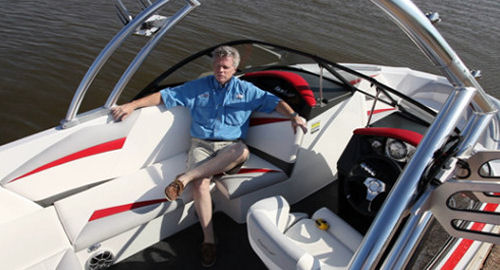
Performance
I couldn't wait to get on the water to test the handling and performance of the R20 to see if Tigé really didn't hold back on the build quality. I am happy to report that this boat handled as well as the high-end Tigé boats, and that means that the hull was just as solid, with no flex, and the performance additions of the Convex V-hull remained intact.
Also, as with the rest of the line, I found that the TAPS system is most effective as a fine-tuning device for the wake when the ballast tanks are full. At the high end of the speed range, I did notice that there was a bit of a bow porpoising, but that was easily stabilized by bringing the TAPS plate down and planting more of the forefoot on the water.
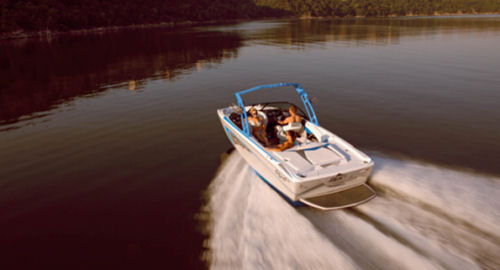
Turns were quick and without a lot of grab, and if you reduce speed a bit just before entering the turn, you can make the stern fishtail around before blasting off in the opposite direction. It's fun to do, so you should try it.
By the Numbers
I reached a top speed at 5300 rpm and 40.8 mph. At that speed the R20 was burning 19.8 gph while getting just over 2 mpg. That translates into a range of 70 miles. Pulled back to a more economic cruise setting of 3500 rpm and the R20 was running at 27.8 mph with only a 7.7 gph fuel burn. Now we were getting 3.63 mpg for a range of 124 miles.
During our test at 3000 rpm the boat's speed was 23.0 mph which most closely approximates the speed that many people will use the boat. At that speed the R20 burns 6.6 gph, gets 3.51 mpg and has a range of 120 statute miles.
Time to plane was only 2.4 seconds which is remarkably fast. I reached 20 mph in 5.3 seconds, and accelerated through 30 mph in 8 seconds.
Observations
My test has shown that the Tigé trademark performance is still there. The size of the wake is the same as with other Tigé models of the same specifications. The hull, deck, stingers and other substructures are the same. The comfort level is still there in a general way, with the exception of the helm seat as noted. The towing arch works fine, it is just not the deluxe version.
Basically, I think that with the Tigé R20 you are getting a premium multi-watersports platform combined with a very cool family runabout. That means that the only important thing missing, is the high price tag.

